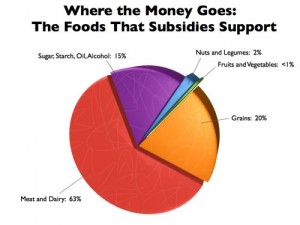Mindful Meatlessnes
I never thought twice about eating meat, partially because I don’t eat a large amount of meat in the first place, and partially because I didn’t know what goes into the meat making process. After this week or two of observing how often I eat meat, I realized come of the causes of this behavior. It occurs mostly out of convenience and partially from what everyone else around me is eating. The production of meat and how it becomes available to the public, is a large factor that makes meat offered to students on a daily basis.
If it is dinnertime and I am starving the most convenient thing for me to get from the school cafeteria is a chicken sandwich. I have had the chicken sandwich before and I know it fills me up. It is not the healthiest thing I could choose, but the chicken does provide a good amount of protein and it is very tasty. Plus, most of the time my friends order the same thing. Even if I go alone, I often order the chicken sandwich because if I ordered a salad, it would be difficult to eat on the go. Additionally, ordering a salad without chicken is not nearly as satisfying as ordering a salad with chicken, even if I was not in a rush. This is just one common example of my thought process when deciding to eat meat.
The production and regulation of meat are just some of the things that influence the over consumption of meat by humans beyond individual behaviors. Agricultural subsidies are one reason that meat is such an accessible food. These subsidies “encourage livestock producers to engage in environmentally damaging activities” (Henning, 2011, p. 75). These agricultural subsidies are what allows “80 percent if the considerable growth in the livestock sector worldwide (to be) from industrial livestock production” (Henning, 2011, p.65). This means that the way livestock is raised is through intensive measures called “concentrated animal feeding operations”, also called CAFOs (Henning, 201). Some predict that this system of raising livestock is providing the general population with the false notion that this method will last us indefinitely. The method also presents behavioral barriers of individuals. People may think that the companies are already producing a certain amount of meat, so when they eat or purchase the meat, they are just consuming it so it doesn’t go to waste. Because of the indirect way we obtain meat, as in we don’t see it raised on the industrial farms, the blame is less our part than it is of the meat-raising companies. What is difficult for many consumers to understand is that consumers control the market: if chicken nugget sales are down and chicken breast sales are up, companies will produce more chicken breast. In this same way, if meat sales are down and tofu sales are up, companies will find a way to produce more tofu in order to profit the most. Individuals don’t often view themselves as having control over the market, but they definitely do.

I never realized that there are so many issues regarding what a single individual consumes. Nonetheless, this challenge has already opened my eyes to the impacts of lifestyle, specifically diet, choices can have on a population. Additionally, this challenge will allow me to adopt a more sustainable way of living, no matter what length of time it is.
References
Henning, B. (2011). Standing in livestock’s ”long shadow”: The ethics of eating meat on a small planet. Ethics & the Environment, 16(2), 63-93. doi:10.2979/ethicsenviro.16.2.63
Leave a Reply